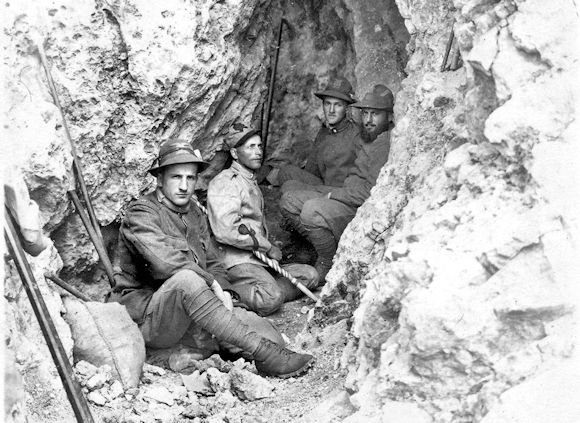Towering over the village of Kobarid (formerly Caporetto) is the Krn Massif, shown above, dominated by two peaks. The shark fin-shaped formation is 2224-meter Mte Krn. To its right is the near-plateau-shape of Mte Batognica, which today is 2164 meters, blunted by mines dug and detonated by Austro-Hungarian forces during the war. Krn was fully captured from its Hungarian defenders by Italian Alpini troops in June 1915. However, Batognica was only partially secured, and for the next 28 months was the site of the sector's front line. Austro-Hungarian troops occupied the eastern part of the mountain while Italian troops were located in the western part. The advance trenches were only 10 meters apart. The attrition of trench warfare and the aforementioned mining operations resulted in enormous casualties. When the combined German-Austrian assault came on 24 October 1917, the entire 43rd Italian Division was surrounded and captured en masse on the Krn-Batognica Ridge, and the entire front was pushed south, eventually to the Piave River line.
Today, the position is very difficult to access—one needs to be at least a moderately experienced climber—but the war remains to be seen on the site, including bunkers, chiseled staircases, and tunnels, are dramatic, and the views of the Soca River valley and surrounding Julian Alps are spectacular. Luckily, the Kobarid war museum and various hiking organizations have made many images available online.
 |
| Closer View of the Massif |











The knowledge and insight you have given over the years to the Italian Alpine front is always appreciated. I know you have headed tours in the past to the area; I would likewise like to tour the area. When you mention the climb requires moderate climbing skills, are you meaning hammering of pitons and ropes? Are there roads part of the way, then trails and chiseled rock staircases with handrails either of rope or metal, or just climbing steep paths? The photo of the monument showing what seems to be a large caliber artillery shell, requiring a heavy piece. If that was an example of the ordinance used, then getting that stuff up there was indeed a feat. Rather I would think they used mountain howitzers, smaller caliber, much lighter, easier to deploy, albeit a feat in itself, along with the resupply of it and the other necessities of battle, like food, medical supplies, evacuation of casualties.
ReplyDeleteHi Parnelli,
DeleteHere's a website that has details on the various possible mountain excursions around Kobarid.
https://www.kobariski-muzej.si/en/exhibitions/guided-tours/guided-tours/201803271701439902/guided-tours-of-former-battlefields/
I'm sure some of your questions are answered on these pages. With my groups, I've taken them on 3A, and small pieces of 3 and 4. There is also a closer-in Kobarid Historical tour that has some hiking that is not too challenging. but takes you to some great sites with great views. It's on this page:
https://www.kobariski-muzej.si/en/exhibitions/guided-tours/guided-tours/201803271700578802/the-kobarid-historical-trail/
Hope this helps,
Mike
For a heart-breaking account of The Great War including the above battle, read Mark Helprin's novel, A Soldier of the Great War. Yes, it's "fiction," that is, though not fact, it is brimming over with truth.
ReplyDeleteTo get up to the top of Krn and Batognica you just need endurance. Most of the trails were built on old mule supply paths. The helmet and light mentioned in the one battlefield tour is because they go into some of the remaining tunnels up on Batognica. For tunnel exploration, I think maybe one of the tours would be the best way to go. There is a lot to see without the tunnels up there, however. Most of the shells that were displayed were 149 mm Italian shells that I remember and those guns were not hauled up here - only the smaller mountain guns. The tour number two is one where some mountain experience comes in handy - the walk is on the ridge continuing to the northwest from Krn.
ReplyDeleteThe mountain theaters up here are incredible to see on good weather days, but remember the troops were up here year round.
The Italian 46th Division was defending from Krn south over Batognica to Mrzli vrh and they were hard pressed by the 50th Austrian Division on top and the German march up the Isonzo Valley from their breakthrough at Tolmin below. The Italian 43rd Division held their ground - mostly on the ridges north of Krn - but both divisions would be captured when Italian engineers blew up prematurely the only bridge that crossed the river in the area.